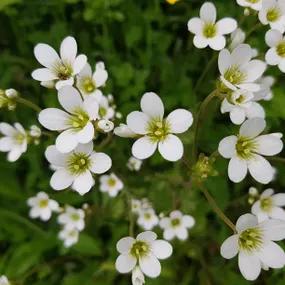'Alpino White' Saxifrage Plants
The details
Saxifraga x arendsii
- Ideal for rockeries & containers
- Hardy evergreen perennial
- White flowers Apr-July
- Matt forming ground cover
- Partial shade tolerant
- Low maintenance
- To 15cm x 30cm
Recommended extras
Description
Rockfoil / Mossy Saxifrage Plants: Saxifraga x arendsii 'Alpino White'. 1 Litre Pots
Part of the Mossy Saxifrage group, Alpino White is a low evergreen perennial that spreads via offsets into a mat of attractive light green ground cover. For such a little plant, it flowers profusely, covered in five petalled white flowers from April into midsummer.
Delivery season: Saxifrage plants are delivered in pots year round, when in stock.
Features:
- Ideal for rockeries & containers
- Hardy evergreen perennial
- White flowers April - Jun/July
- Matt forming ground cover
- Partial shade tolerant
- Low maintenance
- To 15cm x 30cm
Growing Alpino White Saxifrage
These hardy succulents prefer a bit of shade, especially in midday: in the South they are suitable for close to (but not quite) full shade, and in Scotland full sun is generally fine as long as they are sheltered. They require neutral to alkaline, sharply drained, sandy or gritty soil that is consistently moist in the growing season, so they do need watering in dry weather. Like other succulents, they cannot stand being waterlogged, especially in winter.
Trim off the flower stalks when the season is over.
Please note: If you receive your plants in late Autumn or during winter, it is better not to plant them outside until the weather warms up in Spring. They won't establish well in cold soil, and there is a small risk of them failing as a result.
In Your Garden Design
A deceptively powerful and prolific little number that is literally designed to fill in the gaps and crevices of walls, rockeries and tiny hypertufa (limestone/cement) gardens. It has long been a collectors favourite and is beautifully drought resistant making it a climate-friendly gardeners favourite too. When thinking of companion plants to go with it, opt for other alpine- and rock-friendly garden plants, such as euphorbia, sedums, reticulated irises and nepeta. We also have a marvellous mix of alpine plants in one of our popular collections which would partner well.
Did You Know?
Saxifraga means stone breaker (Saxum + frangere), due to their preferred habitat of cracks and crevasses in rocks. It seems that Pliny the Elder, who described a plant in his Natural History called Silaus, thought that the rocks that this plant breaks are gallstones, but it is possible he was referring to something else (maybe celery), and in any case the Latin word for gallstone is calculus.
Georg Adalbert Arends (1863-1952) founded one of Germany's oldest plant nurseries in 1888, after training in Tottenham and eagerly adopting English garden design practices. English bombers then destroyed his nursery during the war, but he rebuilt it with his sons. Since 1998, it has been run by his great-granddaughter, Anja Maubach.


